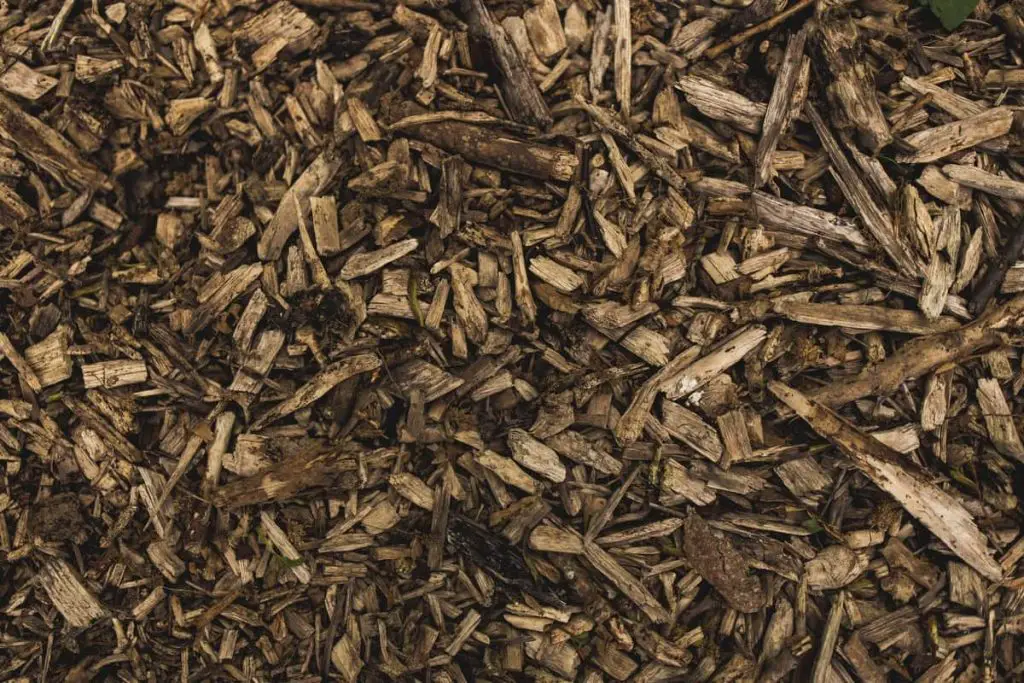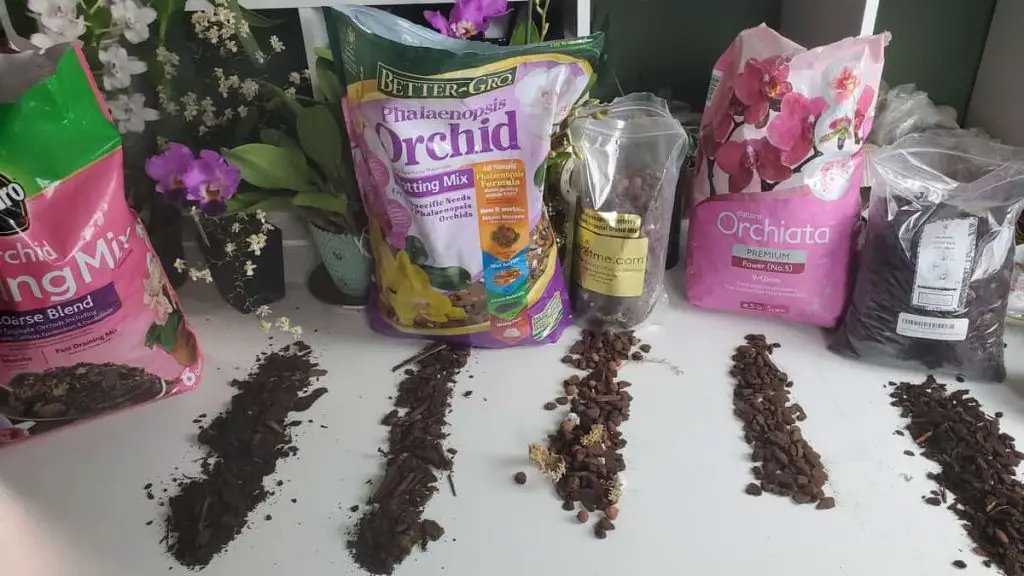If you’ve ever repotted an orchid and ran out of orchid bark in the middle of the process, you’ll relate to this question, “What can I use instead of orchid bark?”
Mulch is an answer that comes up more times than not. After all, they look the same, smell the same, and both are made of trees, right? So how bad would it be to use mulch in the place of orchid bark when you are repotting your orchid? How does mulch stand up as a potting medium for most orchids? In this article, you’re going to learn the basic aspects of mulch and it’s used as a potting medium.
What is the difference between orchid bark and mulch? Orchid bark sold in nurseries and garden centers is made of pine bark and sold depending on the size of the chunks. Mulch can be made of several different organic and inorganic materials.

The purpose of the mulch is to decompose over time. It can consist of 9 different materials, (Organic, wood chips, tree bark, straw, grass clippings or shredded leaves, newspaper or cardboard, cocoa chips, composted animal manure, rock or crusher dust, inorganic material as rocks, rubber, plastic, etc.) which we will look at in more detail below.
Potting media, no matter what you use, must be resistant to decomposition; the longer it withstands heavy fertilization and watering, the better the potting medium. Therefore, mulch is not recommended to be used as potting media straight from the start—its purpose.
Mulch From Wood Chips as Orchid Potting Media
Wood chips might be similar to what you are already using in your potting media. After all, orchid bark potting mixes are mainly pine bark. Yet, the wood chips are not the same thing.
Besides being chemically treated to break down in a short period of time, wood chip mulch is designed to prevent weed germination of seeds. If your orchid is extremely young, seedling size, this is the worst type of potting medium you can use.
This happens because the wood chips, usually from non-discriminate trees depending on the area the company is in (eucalyptus, fir, pine, redwood, cedar, cypress, and others) when freshly cut up into tiny chunks will absorb high quantities of nitrogen from the atmosphere.
Nitrogen is fundamental for root growth, and your orchid roots will decay faster without nitrogen. After 6 to 8 weeks, this nitrogen absorption halts to a minimal standard and can be used in place of orchid bark.
After the 8-week weight period, the wood chips will start to deteriorate, which is much sooner than you want to repot. In this deterioration process, the chips will release more nitrogen, making a viable potting media in terms of nitrogen. Yet, nitrogen isn’t the only chemical element that the chips will release. They also release resins which can be extremely toxic to your orchid.
Orchid bark can be made of several different types of trees depending on the brand, but the majority today use pine or fir bark. In the past companies used redwood bark, and almost depleted the natural resources in vast areas of the United States. Now they are using mainly pine bark. This will also vary depending on the company, but they don’t stray too far from pine or fir bark.
The wood chip mulch you purchase can use cedar in its formation. Sometimes referred to as arborist mulch, these wood chips have special chemicals that enhance the cedar smells. In a garden, this is essential to have around. The aromatic advantages of the wood chips bring that “log cabin” feel to it. Yet, these aromatic oils are in essence harmful for orchid roots.
The Purpose of Mulch VS Orchid Bark
Mulch is sold for 4 main purposes. The first I already mentioned, as it kills young seedlings, meant for weeds. Mulch also raises the temperature of the soil, not allowing the heat to escape. Its purpose was to be used as a top layer, never mixing down in the soil under 4 inches. This is due to the high nitrogen absorption, which would deplete the garden soil of its health.
Yet if used as a potting medium, these freshly cut wood chips in the form of mulch will be in contact with the rhizome, crown, and stem of the orchid. Next to live plant tissue, the mulch interacts with the outer surface plant cells, and nitrogen deficiency can occur in these places of contact.
Mulch also traps in humidity, which as a potting media has its advantages. Most orchids benefit from a potting media that absorbs water and humidity and releases it slowly over time. Mulch tends to not be as fast draining as orchid bark, since there are other components in the mulch.
Some mulch can be made from paper mills and lumber shredders. Sawdust is often a common ingredient in mulch and will absorb way too much moisture, forming a thick, glue-like paste. It serves its purpose to reduce evaporation, but this also means it reduces air circulation around the roots. In this sense, the purpose of the mulch does more harm than good for the orchid.
Different types of Mulch from Tree Bark
You might be thinking that if the wood chips absorb high quantities of nitrogen, why not just ad a fertilizer that’s high in nitrogen, like a 30-10-10? This is actually recommended on your bag of mulch. Any bag you buy will have the suggestion to use a high Nitrogen for the first few weeks.
The problem with this method is that when used on a vegetable or flower garden, this high nitrogen will degrade the chips faster. The more you water and the more you fertilize, the faster the chips decompose. That is their purpose.
Fir bark Mulch Versus Orchid Bark
So why not use Fir bark, just like the orchid bark has in its composition? Mulch made from fir bark can also include fir, pine, and redwood. This is just a common classification that industries which sell fir bark have come to terms with. You really have no idea if that tree is in fact a fir tree (which is actually excellent for not releasing too many resins) or if it is a pine bark, which has a high resin count.
Industries that sell mulch can use any type of wood in the wood chips, including the ones made from leftover pallets. This has been a big financial gain for these industries over the last few years. They chop up the old, used pallets and sell them as mulch. You have no idea or guarantee what kind of wood goes into the wood chip mulch.
In fact, it could be redwood, which recently has been proven to cause respiratory allergies in cats and dogs. If you want more information on that, I wrote these two articles, one about cats and the other about dogs, and how potting media can be toxic if ingested. They can eat the orchid leaves all they want, (hmmm…no comments). They’re fine in that orchids aren’t poisonous.
Orchids are actually edible—not only the vanilla orchid. Some Dendrobiums have had culinary purposes for centuries. If you want a few recipes with orchids, I wrote this article about how to incorporate orchids into your meals… Anyway, I’m getting off point here.
If you can guarantee that the mulch is in fact made from fir bark, and if you let it rest outside for eight weeks to properly oxygenate and absorb the nitrogen it needs before you use it to repot, then I’m all for it.

Pine Bark Mulch Versus Orchid Bark
If you only have access to pine bark, you can still apply the same principle, and it’s much cheaper, too.
Pine bark breaks down quicker than the other materials, generally around 2 to 3 years. This does coincide with most orchid repotting cycle, so if you’re okay with those dates, go for it. Purchase a liquid called blood and bone, or any product that is similar. This is similar to the treated orchid bark which will lower the wood chip’s necessity to draw in nitrogen. The toxin count is also reduced as it sits in this liquid for some time before it’s commercially sold.
The only downside is that I’d only use the pine bark to repot a terrestrial orchid that likes to have a higher alkalinity. Pine bark is not acidic, yet most epiphytic orchids prefer an acidic potting medium.
There are bonsai growers that use pine bark in their potting media and they say pine bark can be successful for up to 10 years. I believe (pending research here) that the long decomposition dates are because that bonsai watering and fertilization quantities are much less than most orchids require. I still am looking for evidence to back that theory up.
The Best Wood Chip Bark for Potting Medium
If you are sold out on using wood chip mulch, then purchase a cypress mulch. Cypress trees grow in swampy areas, with high humidity and are better equipped to resist rot. The constant contact with water keeps them in a more similar situation as if they were in a pot with sphagnum moss and watered constantly. They take longer to decompose.
Can you use Orchid Bark as Mulch in Your Flower Bed?
You can but why would you want to? Orchid bark is about 3 times the price. The only downside in this method is that orchid bark will not degrade as much as the mulch will, since it is treated to withhold its properties for longer periods of time. The whole idea of mulch is to decompose quickly, just providing the right humidity and temperature during winter months. It can be used to decorate flower beds and in landscaping, but then you’d have to have tons of orchid bark.
If you have a bag of orchid bark laying around that you don’t need and have totally given up on orchid care, I suggest finding a Facebook group and donating it to someone near your area. But I highly doubt this is the reason you’re asking…
If you want to know the right potting medium for your orchid, I wrote an article that explains in more detail the different types of potting medium that are more acceptable. You can check that article out here.
If you’ve totally run out of orchid bark and need some more, why not check the prices on Amazon? This is the orchid bark I use (Affiliate Link) for all my orchids, just differentiating the proportions of sphagnum moss, perlite, and charcoal to recreate the habitat they are more accustomed to.
for all my orchids, just differentiating the proportions of sphagnum moss, perlite, and charcoal to recreate the habitat they are more accustomed to.
Don’t Stop Learning!
If you want to be included in more information and get a 14-page fertilization guide, please sign up for my newsletter. I don’t spam, but send emails out bi-monthly with some curious topics of interest. If you want more information, click here to go to a specific page on this website where I explain it more in detail.

Also, if you are looking for an orchid journal to keep your notes specifically about orchid care, check out my 2 solutions for that on this page. If note-keeping isn’t your thing, then there is a free excel spreadsheet that you can download. Click here for more information on how to do that.
If you subscribe to my newsletter, I will send you a 14-page guide on the main tips of orchid fertilizer. It is downloadable and you can print it out on your computer. I designed the guide to double up as a coloring book, just to make it fun.
Happy Cultivating (with Orchid Bark, Not Mulch) !

